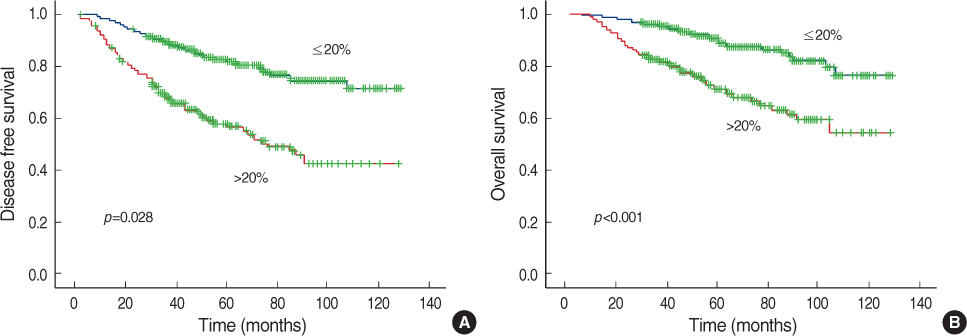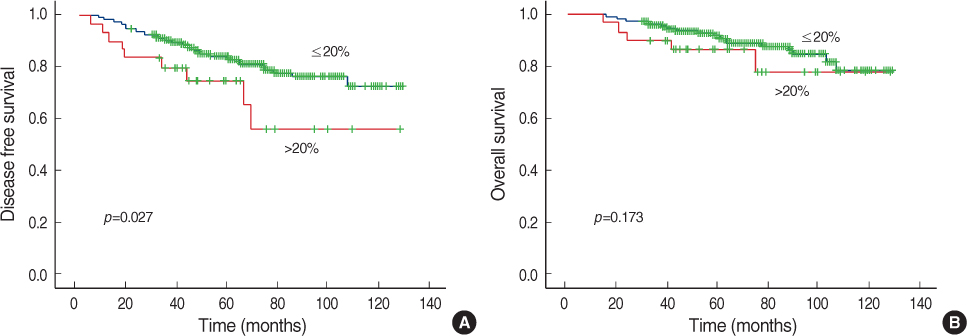J Breast Cancer.
2008 Dec;11(4):194-200. 10.4048/jbc.2008.11.4.194.
The Impact of the Ratio of Positive Nodes to Removed Nodes on Recurrence and Overall Survival in Node Positive Breast Cancer Patients
- Affiliations
-
- 1Department of Surgery, Samsung Medical Center, Sungkyunkwan University School of Medicine, Seoul, Korea. drjh.yang@samsung.com
- KMID: 2286585
- DOI: http://doi.org/10.4048/jbc.2008.11.4.194
Abstract
-
PURPOSE: The status of axillary lymph node (LN) metastasis is the most important prognostic factor in breast cancer. Postoperative regional nodal radiotherapy is recommended usually based on the number of metastatic LNs, which is associated with the total number of removed LNs during the axillary dissection. We evaluated the prognostic impact of the ratio of metastatic LNs to removed LNs on disease free survival and overall survival in breast cancer patients.
METHODS
The medical records of 743 breast cancer patients with metastatic axillary LNs and treated at Samsung Medical Center between 1994 and 2003 were retrospectively analyzed. The ratio of metastatic/removed LNs as well as the other prognostic factors were analyzed.
RESULTS
Both disease-free survival and overall survival rates were significantly worse in patients with a ratio of metastatic/removed LNs greater than 20% compared to those patients with a ratio of less than 20% (p=0.028, p<0.001, respectively). In patients with T1-2 and N1 breast cancer, the ratio of metastatic/removed LNs greater than 20% was significantly associated with poorer disease-free survival (p=0.027).
CONCLUSION
A ratio of metastatic/removed LNs greater than 20% in the axilla can be an adverse prognostic factor in breast cancer patients with axillary node metastasis. In T1-2 N1 breast cancer patients, adjuvant radiotherapy as well as more aggressive chemotherapy therapy may be indicated.
Keyword
MeSH Terms
Figure
Cited by 1 articles
-
The Prognostic Significance of the Lymph Node Ratio in Axillary Lymph Node Positive Breast Cancer
Ji-Yoon Kim, Mi-Ryeong Ryu, Byung-Ock Choi, Woo-Chan Park, Se Jeong Oh, Jong-Man Won, Su-Mi Chung
J Breast Cancer. 2011;14(3):204-212. doi: 10.4048/jbc.2011.14.3.204.
Reference
-
1. Fitzgibbons PL, Page DL, Weaver D, Thor AD, Allred DC, Clark GM, et al. Prognostic factors in breast cancer. College of American Pathologists Consensus Statement 1999. Arch Pathol Lab Med. 2000. 124:966–978.2. Singletary SE, Allred C, Ashley P, Bassett LW, Berry D, Bland KI, et al. Staging system for breast cancer: revisions for the 6th edition of the AJCC Cancer Staging Manual. Surg Clin North Am. 2003. 83:803–819.
Article3. Atkinson EN, Brown BW, Montague ED. Tumor volume, nodal status, and metastasis in breast cancer in women. J Natl Cancer Inst. 1986. 76:171–178.4. Carter CL, Allen C, Henson DE. Relation of tumor size, lymph node status, and survival in 24,740 breast cancer cases. Cancer. 1989. 63:181–187.
Article5. Sauerbrei W, Royston P, Bojar H, Schmoor C, Schumacher M. Modelling the effects of standard prognostic factors in node-positive breast cancer. German Breast Cancer Study Group (GBSG). Br J Cancer. 1999. 79:1752–1760.
Article6. Recht A, Edge SB, Solin LJ, Robinson DS, Estabrook A, Fine RE, et al. Postmastectomy radiotherapy: clinical practice guidelines of the American Society of Clinical Oncology. J Clin Oncol. 2001. 19:1539–1569.
Article7. Recht A, Edge SB. Evidence-based indications for postmastectomy irradiation. Surg Clin North Am. 2003. 83:995–1013.
Article8. Truong PT, Olivotto IA, Whelan TJ, Levine M. Clinical practice guidelines for the care and treatment of breast cancer: 16. Locoregional post-mastectomy radiotherapy. CMAJ. 2004. 170:1263–1273.
Article9. Overgaard M, Nielsen HM, Overgaard J. Is the benefit of postmastectomy irradiation limited to patients with four or more positive nodes, as recommended in international consensus reports? A subgroup analysis of the DBCG 82 b&c randomized trials. Radiother Oncol. 2007. 82:247–253.
Article10. Overgaard M, Jensen MB, Overgaard J, Hansen PS, Rose C, Andersson M, et al. Postoperative radiotherapy in high-risk postmenopausal breast-cancer patients given adjuvant tamoxifen: Danish Breast Cancer Cooperative Group DBCG 82c randomised trial. Lancet. 1999. 353:1641–1648.
Article11. Ragaz J, Olivotto IA, Spinelli JJ, Phillips N, Jackson SM, Wilson KS, et al. Locoregional radiation therapy in patients with high-risk breast cancer receiving adjuvant chemotherapy: 20-year results of the British Columbia randomized trial. J Natl Cancer Inst. 2005. 97:116–126.
Article12. Katz A, Strom EA, Buchholz TA, Thames HD, Smith CD, Jhingran A, et al. Locoregional recurrence patterns after mastectomy and doxorubicin-based chemotherapy: implications for postoperative irradiation. J Clin Oncol. 2000. 18:2817–2827.
Article13. Katz A, Buchholz TA, Thames H, Smith CD, McNeese MD, Theriault R, et al. Recursive partitioning analysis of locoregional recurrence patterns following mastectomy: implications for adjuvant irradiation. Int J Radiat Oncol Biol Phys. 2001. 50:397–403.
Article14. Wallgren A, Bonetti M, Gelber RD, Goldhirsch A, Castiglione-Gertsch M, Holmberg SB, et al. Risk factors for locoregional recurrence among breast cancer patients: results from International Breast Cancer Study Group Trials I through VII. J Clin Oncol. 2003. 21:1205–1213.
Article15. van der Wal BC, Butzelaar RM, van der Meij S, Boermeester MA. Axillary lymph node ratio and total number of removed lymph nodes: predictors of survival in stage I and II breast cancer. Eur J Surg Oncol. 2002. 28:481–489.
Article16. Megale Costa LJ, Soares HP, Gaspar HA, Trujillo LG, Santi PX, Pereira RS, et al. Ratio between positive lymph nodes and total dissected axillaries lymph nodes as an independent prognostic factor for disease-free survival in patients with breast cancer. Am J Clin Oncol. 2004. 27:304–306.
Article17. Vinh-Hung V, Verschraegen C, Promish DI, Cserni G, Van de Steene J, Tai P, et al. Ratios of involved nodes in early breast cancer. Breast Cancer Res. 2004. 6:R680–R688.
Article18. Truong PT, Berthelet E, Lee J, Kader HA, Olivotto IA. The prognostic significance of the percentage of positive/dissected axillary lymph nodes in breast cancer recurrence and survival in patients with one to three positive axillary lymph nodes. Cancer. 2005. 103:2006–2014.
Article19. Kuru B. Prognostic significance of total number of nodes removed, negative nodes removed, and ratio of positive nodes to removed nodes in node positive breast carcinoma. Eur J Surg Oncol. 2006. 32:1082–1088.
Article20. Fortin A, Dagnault A, Blondeau L, Vu TT, Larochelle M. The impact of the number of excised axillary nodes and of the percentage of involved nodes on regional nodal failure in patients treated by breast-conserving surgery with or without regional irradiation. Int J Radiat Oncol Biol Phys. 2006. 65:33–39.
Article
- Full Text Links
- Actions
-
Cited
- CITED
-
- Close
- Share
- Similar articles
-
- The Number of Removed Lymph Nodes for an Acceptable False Negative Rate in Sentinel Lymph Node Biopsy for Breast Cancer
- The Prognosis of breast Cancr with more than 10 Positive Nodes
- Optimized Criteria for Sentinel Lymph Node Biopsy in Patients with Clinically Node Negative Breast Cancer
- Clinical Study of Breast Cancer Patients Who Had More Than 10 Positive Axillary Lymph Nodes
- The Prognostic Significance of the Lymph Node Ratio in Axillary Lymph Node Positive Breast Cancer



